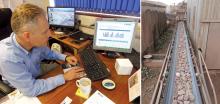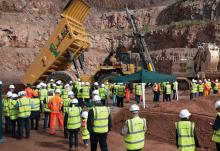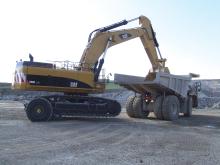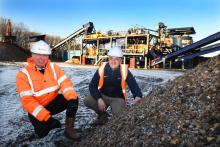RSSLimestone from
Thousands of tonnes of material from Dowlow in County Derbyshire and Thrislington in County Durham, England, are being supplied to the reinvigorated Teesside steel works.
It is the first time Lafarge Aggregates & Concrete UK has directly sold into the steelmaking market from Dowlow and the deal could see around 500,000tonnes a year supplied from the quarry.
Steve Lea, Lafarge northern aggregates sales manager said: “This is a fantastic opportunity for us and we are proud to be part of the return of steelmaking in the north-east.
“Not only will this bring jobs back to the plant but it will cascade down to all the companies which provide associated services and be a real catalyst for regeneration.”
Mothballed by
After many months of preparation the monstrous blast furnace, as big as St Paul’s Cathedral (London), and one of the largest in Europe, was relit on 15 April.
In preparation for the relight, Lafarge supplied by rail initial orders of 15,000tonnes of both carboniferous limestone from Dowlow and dolomitic limestone, useful for absorbing silica in the iron ore, from Thrislington.
The Dowlow delivery was the first stock of raw material to reach the steel works, ahead of a shipment of iron ore from Brazil, while the Thrislington cargo required the opening of the site’s railhead for the first time in 23 years.
Site manager, Steve Carter, said: “The last train went from Thrislington in 1993 so to see the wagons load and move off was quite a momentous sight. Our railhead is now fully functional again which is great.”
Peter Wheeldon, product technical manager, explained various aspects of Lafarge’s operations appealed to SSI, including “quality of current and future mineral and impressive sustainable transport credentials.”
He said: “The reopening of the Redcar plant is of immense importance for Teesside, there is a real buzz around the place and a renewed optimism. We are very excited to be part of that.”
An essential element in iron-making (the first step towards creating steel) limestone absorbs impurities in the blast furnace, forming liquid slag which can then be separated from the liquid iron which goes on to make the steel. Lafarge’s limestone is mixed into a 170,000tonne stockpile of iron ore and coke dust to form sinter.
This combination is partly burnt at a sinter plant where it forms large lumps called a sinter bed which can be more easily handled by the blast furnace.
The sinter bed, lump iron ore and lump coke are then put in the furnace and cooked at temperatures greater than 1,500°C to create iron.
The blast furnace now fired up is expected to burn constantly for the next 15 years, producing 11,000tonnes of iron a day.








